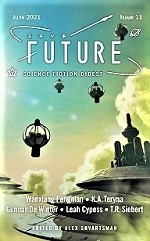 Future Science Fiction Digest #11, June 2021
Future Science Fiction Digest #11, June 2021
“Knights of the Phantom Realm” by Wanxiang Fengnian (translated by Nathan Faries)
“The Jellyfish” by K. A. Teryna (translated by Alex Shvartsman)
“Artificial Zen at the End of the World” by Gunnar De Winter
“Unredacted Reports from 1546” by Leah Cypess
“Follow” by T. R. Siebert
Reviewed by Kevin P Hallett
The 11th issue of Future Science Fiction Digest has five original short stories from around the world. One of which is a novelette.
“Knights of the Phantom Realm” by Wanxiang Fengnian (translated by Nathan Faries)
Little Gebu lives inside the last human city in this SF novelette set in a post-apocalyptic future. The city has high transparent walls to keep out the phantoms that swirl around outside. On Gebu’s eleventh birthday, the city wall cracks, and the phantoms break into the city riding on a sandstorm. Those that survive the first wave rush to underground caverns, but Gebu eschews this pitiful pretense of survival and decides to leave the city’s remnants to find something better outside.
The world is full of phantom images of volcanoes spewing lava and mirages hiding precipitous cliffs. But one small phantom turns out to be genuine, a talking cat aptly named Snowball. Snowball offers to be Gebu’s guide as they set off toward the rising sun.
They get to know each other during their walk, and Gebu discovers what the world was like before humanity released the phantoms on itself. The boy hopes to find another human city; what he finds instead shakes his beliefs to their core.
This was an unusual story with a mysterious plot that held the reader’s interest. Though at times the story’s imagery lacked originality.
“The Jellyfish” by K. A. Teryna (translated by Alex Shvartsman)
Kalinka is dirt-poor in this short SF set in a future where ‘likes’ are the currency. She is a hermit and cannot post anything to generate the likes she needs to avoid dropping down the social ladder and becoming a mere number.
When a multicolored jellyfish appears in her cell, it represents a way to climb the social ladder instead of dropping. All she has to do is deliver it to the head office. But she only has seven likes left and must hide the jellyfish to avoid aggressive players stealing it during the trip. As she sneaks it to the head office, the jellyfish begins stinging her with the story of her youth, but she knows not why.
“The Jellyfish” was a curious view of the future, and though the tale dragged a little in the middle, the ending rendered a twist that was hard to predict.
“Artificial Zen at the End of the World” by Gunnar De Winter
Set in a distant post-apocalyptic future, this short SF chronicles the efforts of the last still operating robot. Most creatures died in the radioactive soil, including those that created the robot. And so, the robot’s companions are primarily insects. If life is to come back, it reasons, it must start gardening the desolate land.
The story is yet another view of the world humanity is threatening to create. Nicely told, but rather apparent in its conclusions.
“Unredacted Reports from 1546” by Leah Cypess
A sixteen-year-old history student travels back to 1546 in this short SF story. She is searching for an allusive writer called Lucia, who wrote a haunting poem that has become a clarion call for women in the twenty-first century.
The student struggles with the realities of the sixteenth century’s misogynist treatment of women authors. But after some effort, she finds her target hidden in an unexpected place. Lucia has changed her name and her views, leaving the modern-day teenager lost as to how to continue. But her search has revealed new truths about herself. Ones she wanted to keep hidden.
This was a character-centric story that explored a teenager’s coming of age as far as her emotions were concerned. It also provided some historical perspective for the treatment of intelligent women during the Renaissance.
“Follow” by T. R. Siebert
“Follow” is a short science fiction story about Anna chasing across the galaxy to pursue the ghost of her lover Neda. When she reaches the next planet, she finds Neda’s specter outlined by the microscopic nanobots that tended to her and still remember her outline.
Neda created the nanobots that keep her alive and also serve Anna during her quest. But the bots had a flaw, causing Neda to try and escape from civilization. Leaving Anna to chase after her decades later in the hope of … Anna isn’t sure what she hopes for really.
The author crafted an intriguing story that begrudgingly revealed only a few of its mysteries.
You can follow Kevin P Hallett’s writing on www.kevinphallett.com.